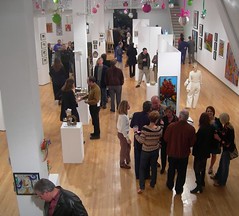Bourgeoisie is a classification used in analyzing human societies to describe the upper middle social class of people, says Wikipedia.
The bourgeoisie are members of the upper or merchant class, whose status or power comes from employment, education, and wealth. They are distinguished from those whose power comes from being born into an aristocratic family.
The term petite bourgeoisie (also petty bourgeoisie) is used to describe the class below the bourgeoisie but above the proletariat.
The term "urban haute bourgeois" describes American upper-class WASPs.
WASPs have been the dominant ethnic group (white, Anglo-Saxon, Protestant) for most of US history. Until JFK in 1960 all presidents had been WASPs. Most US business leaders and Senators were WASPs during the 1700's and 1800's. Generally, they were bourgeois or of the wealthy class.
WASPs were guilty of excluding Jews, Blacks, Southern Europeans (ex, Italians), Irish and Asians from the better housing and jobs in US life. During the Holocaust, WASP members of the US government severely limited Jewish immigration to the US - despite knowledge of Hitler's extermminations.
In common usage the term has pejorative connotations suggesting either undeserved wealth, or lifestyles, tastes, and opinions that lack the sophistication of the rich or the authenticity of the intellectual or the poor, continues Wikipedia. In the United States, where social class affiliation lacks some of the structure and rules of many other nations, "bourgeoisie" is sometimes used to refer to those seen as being either upper class or upper middle class. It is rare for people in the English speaking world to identify themselves as members of the bourgeoisie, although many self-identify as middle class.
In the late Middle Ages, as cities were emerging, artisans and tradesmen began to emerge as both a physical and economic force. They formed guilds, associations and companies to conduct business and promote their own interests. These people were the original bourgeoisie. In the late Middle Ages (the 14th and 15th centuries), they were the highest guildsmen and artisans, as evidenced in their ability to pay the fines for breaking sumptuary laws, and by paying to be called citizens of the city in which they lived or the ability to be called bourgeoisie. In fact the King of France granted nobility to all of the bourgeoisie of Paris in the late fourteenth century. They eventually allied with the kings in uprooting the feudalist system.
After the Middle Ages and going into the renaissance they were gradually becoming the ruling class in industrialised nation-states. In the 17th and 18th century, they generally supported the American revolution and French revolution in overthrowing the laws and privileges of the absolutist feudal order, clearing the way for the rapid expansion of commerce and the establishment of a capitalist society.
The bourgeoisie was never without its critics; it was first accused of narrow-mindedness, materialism, hypocrisy, and lack of culture, among other things, by persons such as the playwright Truldière and the novelist Flaubert, who denounced its supposed banality and mercenary aspirations.
The term is essential to the Communist Manifesto, by Karl Marx and Friedrich Engels; it's equivalent to the Upper Class.
Friday, October 17, 2008
Subscribe to:
Post Comments (Atom)





No comments:
Post a Comment